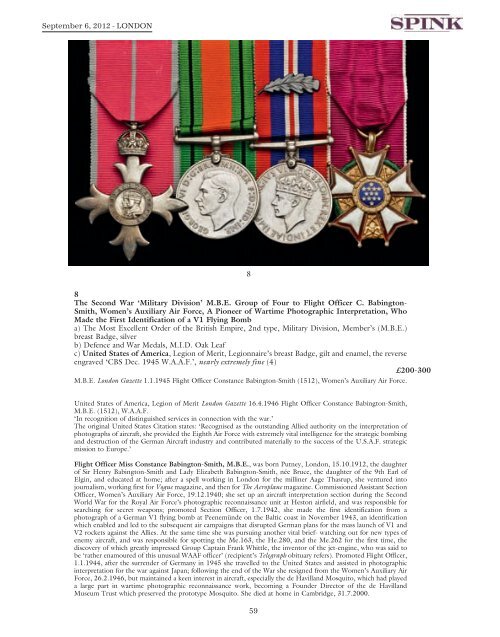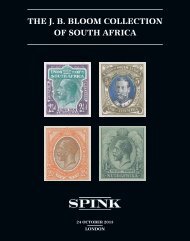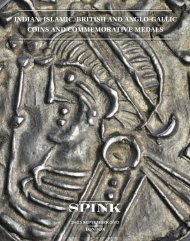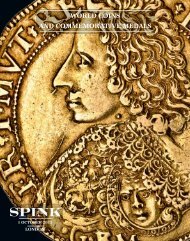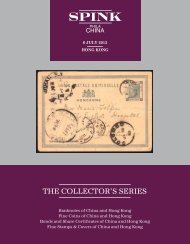bentley priory - Spink
bentley priory - Spink
bentley priory - Spink
You also want an ePaper? Increase the reach of your titles
YUMPU automatically turns print PDFs into web optimized ePapers that Google loves.
September 6, 2012 - LONDON<br />
8<br />
8<br />
The Second War ‘Military Division’ M.B.E. Group of Four to Flight Officer C. Babington-<br />
Smith, Women’s Auxiliary Air Force, A Pioneer of Wartime Photographic Interpretation, Who<br />
Made the First Identification of a V1 Flying Bomb<br />
a) The Most Excellent Order of the British Empire, 2nd type, Military Division, Member’s (M.B.E.)<br />
breast Badge, silver<br />
b) Defence and War Medals, M.I.D. Oak Leaf<br />
c) United States of America, Legion of Merit, Legionnaire’s breast Badge, gilt and enamel, the reverse<br />
engraved ‘CBS Dec. 1945 W.A.A.F.’, nearly extremely fine (4)<br />
£200-300<br />
M.B.E. London Gazette 1.1.1945 Flight Officer Constance Babington-Smith (1512), Women’s Auxiliary Air Force.<br />
United States of America, Legion of Merit London Gazette 16.4.1946 Flight Officer Constance Babington-Smith,<br />
M.B.E. (1512), W.A.A.F.<br />
‘In recognition of distinguished services in connection with the war.’<br />
The original United States Citation states: ‘Recognised as the outstanding Allied authority on the interpretation of<br />
photographs of aircraft, she provided the Eighth Air Force with extremely vital intelligence for the strategic bombing<br />
and destruction of the German Aircraft industry and contributed materially to the success of the U.S.A.F. strategic<br />
mission to Europe.’<br />
Flight Officer Miss Constance Babington-Smith, M.B.E., was born Putney, London, 15.10.1912, the daughter<br />
of Sir Henry Babington-Smith and Lady Elizabeth Babington-Smith, née Bruce, the daughter of the 9th Earl of<br />
Elgin, and educated at home; after a spell working in London for the milliner Aage Thasrup, she ventured into<br />
journalism, working first for Vogue magazine, and then for The Aeroplane magazine. Commissioned Assistant Section<br />
Officer, Women’s Auxiliary Air Force, 19.12.1940; she set up an aircraft interpretation section during the Second<br />
World War for the Royal Air Force’s photographic reconnaissance unit at Heston airfield, and was responsible for<br />
searching for secret weapons; promoted Section Officer, 1.7.1942, she made the first identification from a<br />
photograph of a German V1 flying bomb at Peenemünde on the Baltic coast in November 1943, an identification<br />
which enabled and led to the subsequent air campaigns that disrupted German plans for the mass launch of V1 and<br />
V2 rockets against the Allies. At the same time she was pursuing another vital brief- watching out for new types of<br />
enemy aircraft, and was responsible for spotting the Me.163, the He.280, and the Me.262 for the first time, the<br />
discovery of which greatly impressed Group Captain Frank Whittle, the inventor of the jet-engine, who was said to<br />
be ‘rather enamoured of this unusual WAAF officer’ (recipient’s Telegraph obituary refers). Promoted Flight Officer,<br />
1.1.1944, after the surrender of Germany in 1945 she travelled to the United States and assisted in photographic<br />
interpretation for the war against Japan; following the end of the War she resigned from the Women’s Auxiliary Air<br />
Force, 26.2.1946, but maintained a keen interest in aircraft, especially the de Havilland Mosquito, which had played<br />
a large part in wartime photographic reconnaissance work, becoming a Founder Director of the de Havilland<br />
Museum Trust which preserved the prototype Mosquito. She died at home in Cambridge, 31.7.2000.<br />
59


